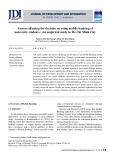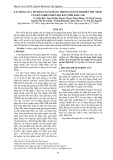
“The EUrASEANs: journal on global socio-economic dynamics”
Volume 4 (29); July - August, Year 2021;
ISSN 2539 – 5645 (Print)
Copyright © 2021, [The EUrASEANs]
on-line access: https://www.euraseans.com/4(29)
All issues of this journal are alternatively stored and archived by: the National Library of Thailand, Russian E-library and Index Copernicus
library of journals, Poland
Ai Tran Huu
PhD, Lecturer of Faculty of Economics, Van Hien University, Ho Chi Minh City,
Vietnam.
Research interests: markets of agricultural products; SMEs functioning under government
support; organic food markets; corporate social responsibility.
E-mail: aith@vhu.edu.vn
My Phan Thi Chieu
MBA, Lecturer of Faculty of Economics,Van Hien University, Ho Chí Minh City,
Vietnam.
Research interests: markets of agricultural products; organic food markets; ecological
economics.
E-mail: MyPTC@vhu.edu.vn.
FACTORS INFLUENCING THE QUALITY OF CREDIT
IN COMMERCIAL BANKS OF VIETNAM
Ai Huu Tran
Mỹ Phan Thi Chieu
Van Hien University, Ho Chi Minh, Vietnam
The study aims to determine the factors affecting credit quality at commercial banks and
analyze the degree of influence of those factors on credit quality. Usable data were collected
from face-to-face interviews with 347 survey subjects — credit officers at the Head Office,
credit directors of some bank branches, and credit officers of joint-stock commercial banks.
The research results show that seven factors affecting credit quality can be arranged in the
following descending order of impact, namely: Credit officer, Credit policy, Management
capacity, Banking technology, Risk management, Organizational work, Mobilized capital.
Basing on the obtained results, some solutions are proposed to improve the credit quality at
commercial banks in Vietnam.
Keywords: credit quality, credit officers, commercial banks, Vietnam
Introduction
Currently, income from credit activities accounts for the largest proportion of banks’
revenue. Although the COVID-19 epidemic’s complications are now being prolonged, many
banks are still confident in striving for profit growth thanks to effective revenue

The EUrASEANs: journal on global socio-economic dynamics, № 4 (29), 2021
43
diversification. The soaring profits of banks in the first quarter of 2021 can be explained by
more optimistic credit growth and non-credit income as compared to the same period last
year. In addition, banks also maintain good profit margins.
As the world is now entering the 4th Industrial Revolution, a revolution where
advanced technologies such as virtual reality, the Internet of things, big data, artificial
intelligence, etc. can be applicable to all the aspects of economic and social life. In this
context, Vietnamese joint-stock commercial banks are gradually integrating, affirming the
growth in all the aspects of their activities, especially credit activities, effectively serving the
growth of the economy.
In 2021, Vietcombank plans to increase its total assets by 5%; credit balance increased
by 10.5% and adjusted according to the direction of the State Bank. Capital has been
mobilized in accordance with the capital use demand, and it is expected to be 7%.
Consolidated bank's pre-tax profit increased by 11%, of which, individual bank's profit was
VND 25,000 billion. With the current foundation, Vietcombank's business results are
expected to be very positive. Regarding the distribution of life insurance, last year VCB was
ranked 13th at the market for life insurance distribution. In the first quarter of 2021, it went
up to the 8th place with the total revenue recorded this year of more than VND 2,800 billion.
In 2021, Techcombank sets a profit before tax target to be around VND 19,800 bln,
this is 25.3% up, as compared to the 2020 result. The credit balance is expected to reach
nearly VND 356.2 trln, up by at least 125% as compared to the last year and within the level
allowed by the State Bank (SBV). In the first quarter of 2021, Kienlongbank's consolidated
pre-tax profit reached VND 702.62 bln. This rate of growth became possible thanks to the
bank's cooperation with customers while handling all collateral assets and completing the
recovery of principal and interest receivables of loans secured by the shares of Sacombank
under the basic plan restructuring Kienlongbank in association with bad debt settlement as
approved by the State Bank. In the context of the above practice, identification of the
influencing factors as well as assessment of the influence of the credit quality factors under
the current integration period needs to offer solutions in order to improve the credit quality
of the joint-stock commercial banks in Vietnam as this is an urgent problem for many bank
top managers in the country.
Literature review
Bank credit is a transaction of assets (money or goods) between a bank and a customer
in which the lender transfers the property to the borrower for the use within a specified
period of time, based on an agreement refund principle.
In the service sector, service quality can be defined in different ways, depending on the
research object and research environment. For example, according to (Parasuraman et al.,
1994), service quality is the gap between customers' expectations and their perceptions when
using the service. And according to (Laidroo, 2017), service quality must be evaluated in two
aspects: (1) service delivery process, and (2) service results. Nguyen Van Tien and Nguyen
Thu Thuy (2014) introduced the concept of bank credit quality which, in their understanding,
is the aggregate economic indicator, reflecting the level of meeting customers' reasonable
loan requirements, in line with credit policy use, ensuring safety and bringing economic
efficiency to the bank. At the same time, it also needs to be contributing to socioeconomic
development promotion.

FACTORS INFLUENCING THE QUALITY
44
This study approaches the research problem from the perspective that the credit quality
of banks should be concerned with the two key objectives: (1) affirming the leading role in
the credit system for the economy, (2) ensuring the achievement of growth, safety, and
profitability of business capital in accordance with the planned objectives and legal
regulations in each period.
Overview of the factors affecting credit quality carried out in the previous studies
shows that there are quite many factors affecting the credit quality of banks, however, within
the scope of this study, the authors would like to focus on the factors belonging to “the inside
of a bank”, that is, from the perspective of bank managers. In addition, the authors propose
the element of "strictly controlling credit for potentially risky fields such as real estate,
securities", that is supposed to be strengthening risk management of consumer credit within
the group of customers with large outstanding loans, ensuring appropriate growth and
striving to achieve a bad debt ratio of less than 2.
In fact, after adverse shocks, in the case of the economies where the banking sector is
well capitalized, bank lending tends to decline less. This indirectly proves that bank capital
has the ability to absorb shocks of the economy. At the same time, the moral hazard problem
is alleviated when banks are highly capitalized (Faiçal, 2014). Ahmed and Malik (2015),
when studying the banking system crisis in developed and developing countries in the period
1980-1994, found that: banking crisis disrupted credit flows for households and businesses,
reducing investment and consumption and driving businesses into bankruptcy. Because bank
activities have a significant influence on the economy, their regulation must be strict and
must include banking supervision (Al-Haj, 2004).
Hypotheses and research models
Research hypothesis
Credit policy: to implement a credit strategy management or the Board sets forth the
policies that become the basis for the formation of the credit process with detailed
professional instructions and specific steps in the credit granting process. Credit policy also
stipulates loan limits for customers, debt classification, provisioning, etc. This policy must
outline the operational direction for credit officers and provide a clear frame of reference to
serve as a basis for considering loan needs.
Therefore, our hypothesis H1 can be formulated as follows:
The higher the credit policy, the better the lending activity and vice versa.
In other words, credit policy and credit quality have a positive relationship.
Management capacity: Credit management is always the most important tool for bank
leaders through which they conduct governance, according to the planned credit strategy and
policy. The general principle while building an effective organizational structure is to
separate the strategic planning function of the Board of Directors, the function of organizing
and operating the Board of Directors, and the function of monitoring and controlling the
Board of Directors. Currently, in many banks, the organizational structure and credit
administration are implemented according to two popular models, namely: centralized credit
management model and distributed credit management model. There is also a combined
model which has the elements of both centralization and distribution. That is, depending on
the field, industry, type of product or service, or the customer, a centralized management

The EUrASEANs: journal on global socio-economic dynamics, № 4 (29), 2021
45
model can be applied at the head office and become more decentralized, down to each
branch.
Thus, we formulate our hypothesis H2 as follows:
Bank's management personnel with good knowledge and experience positively affects
credit quality. Strict and scientific internal control and inspection activities are carried out
regularly, thus positively impacting credit quality.
Banking technology: The financial/banking sector is an industry with a high level of
information technology application. Today’s advanced information technology systems are
able to meet the requirements of accuracy, large transaction volume of customers, active and
detailed search for customer information, help with decision-making while processing loans,
etc. Equipment, machinery, other technical means, and information technologies available
today are quite able to facilitate the simplification of procedures, shorten transaction time,
faster and more accurate information collection, and cost-saving at the same time. Also,
banks’ information sources today are not only diversified but are also offering high rates of
accuracy, thus positively affecting credit quality.
Therefore, we formulate our hypothesis H3 as follows:
Today’s technological equipment, safe and reliable banking, credit assessment
software have a positive impact on credit quality.
Credit risk management: Credit risk management is the process by which banks plan,
organize, implement, and supervise all credit-granting activities in order to maximize profit
in banks with an acceptable level of risk. Credit risk is the possibility that a customer will not
meet his or her repayment obligations under agreed terms. Credit risk has many causes, but
in general, the main reason is the implementation of the credit management process of
commercial banks.
Thus, our hypothesis H4 is as follows:
Clear and detailed credit regulations and processes and compliance by credit officers
have a positive impact on credit quality.
Organizational work: Credit organization and administration are always the most
important tools for bank leaders while performing governance in accordance with the credit
strategy and policy as planned and determined. The general principle of building an effective
organizational structure is to separate the strategic planning function of the Board of
Directors, the function of organizing and operating the Board of Directors, and the function
of monitoring and controlling of the Board of Directors.
Therefore, our hypothesis H5 is formulated as follows:
Credit organization and administration are rated higher, the better the lending
activity.
In other words, credit organization and administration and lending activities are
positively correlated.
Credit officer: Human resources are central to all business activities of commercial
banks, especially credit-related ones. Credit operations are getting increasingly complex
today, requiring qualified personnel, capacity, thinking ability, sensitivity and professional

FACTORS INFLUENCING THE QUALITY
46
ethics. These are the decisive factors for the success of the banking system's efficiency and
improvement of credit quality.
Thus, our hypothesis H6 can be formulated as follows:
The higher the credit officer is rated, the better is the lending activity.
In other words, credit officers and the composition of lending activities are positively
correlated.
Mobilized capital: This is the largest source of capital in almost any bank. This is the
monetary value from economic organizations and individuals mobilized by a bank through
the process of performing deposit and other operations to be used as capital for future
business purposes. The nature of this mobilized capital is assets belonging to different
owners, while the bank only has the right to use it without ownership and is responsible for
timely repayment of both principal and interest when it is due (if it is a term deposit) or when
the customer needs to withdraw capital (if it is a demand deposit). Mobilized capital plays a
highly important role in business activities on any bank.
Thus, our hypothesis H7 can be formulated as follows:
Mobilized capital and credit planning are positively correlated.
Research models
Table 1 - Summary of the scales borrowed from other researchers
(Source: Compiled by the authors from the sources directly mentioned in the table)
Credit policy
A. Burak Guner (2007), Faiçal Belaid (2014), Laivi Laidroo & Kadri
Männasoo (2017)
Management capacity
Faiçal Belaid (2014),
Banking technology
Dương Thị Hoàn (2019); Laivi Laidroo & Kadri Männasoo (2017)
Risk management
Nguyễn Như Dương (2018; Laivi Laidroo & Kadri Männasoo (2017)
Organizational work
Nguyễn Như Dương (2018); Laivi Laidroo & Kadri Männasoo (2017)
Credit officer
Dương Thị Hoàn (2019); Laivi Laidroo & Kadri Männasoo (2017)
Mobilized capital
Nguyễn Thị Thu Đông (2012);
Laivi Laidroo & Kadri Männasoo (2017)
Research Methodology
This study has been conducted in two main phases: (1) Qualitative research to identify,
adjust and supplement the scales affecting the credit quality of banks, (2) Formal research to
collect and analyze the survey data, test scales, hypotheses, and research models.
In our previous study, the author already explored the factors affecting the credit
quality of banks. Qualitative research was conducted with ten top managers at ten active
banks in order to find the concordance between the observed variables and also to find new
variables for potential observation.
The author has conducted a survey to test the concordance of the variables with the
number of respondents being 50. Our survey participants have been managers and credit
officers of joint stock commercial banks in Vietnam. The survey forms have been sent,


























